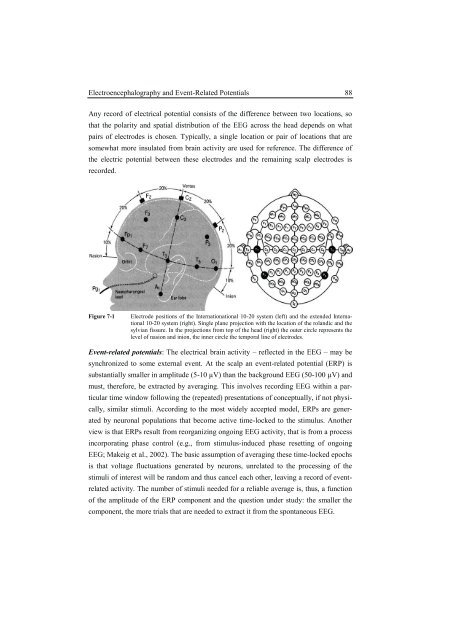Neural Correlates of Processing Syntax in Music and ... - PubMan
Neural Correlates of Processing Syntax in Music and ... - PubMan
Neural Correlates of Processing Syntax in Music and ... - PubMan
You also want an ePaper? Increase the reach of your titles
YUMPU automatically turns print PDFs into web optimized ePapers that Google loves.
Electroencephalography <strong>and</strong> Event-Related Potentials 88<br />
Any record <strong>of</strong> electrical potential consists <strong>of</strong> the difference between two locations, so<br />
that the polarity <strong>and</strong> spatial distribution <strong>of</strong> the EEG across the head depends on what<br />
pairs <strong>of</strong> electrodes is chosen. Typically, a s<strong>in</strong>gle location or pair <strong>of</strong> locations that are<br />
somewhat more <strong>in</strong>sulated from bra<strong>in</strong> activity are used for reference. The difference <strong>of</strong><br />
the electric potential between these electrodes <strong>and</strong> the rema<strong>in</strong><strong>in</strong>g scalp electrodes is<br />
recorded.<br />
Figure 7-1 Electrode positions <strong>of</strong> the Internationational 10-20 system (left) <strong>and</strong> the extended International<br />
10-20 system (right). S<strong>in</strong>gle plane projection with the location <strong>of</strong> the rol<strong>and</strong>ic <strong>and</strong> the<br />
sylvian fissure. In the projections from top <strong>of</strong> the head (right) the outer circle represents the<br />
level <strong>of</strong> nasion <strong>and</strong> <strong>in</strong>ion, the <strong>in</strong>ner circle the temporal l<strong>in</strong>e <strong>of</strong> electrodes.<br />
Event-related potentials: The electrical bra<strong>in</strong> activity – reflected <strong>in</strong> the EEG – may be<br />
synchronized to some external event. At the scalp an event-related potential (ERP) is<br />
substantially smaller <strong>in</strong> amplitude (5-10 μV) than the background EEG (50-100 μV) <strong>and</strong><br />
must, therefore, be extracted by averag<strong>in</strong>g. This <strong>in</strong>volves record<strong>in</strong>g EEG with<strong>in</strong> a particular<br />
time w<strong>in</strong>dow follow<strong>in</strong>g the (repeated) presentations <strong>of</strong> conceptually, if not physically,<br />
similar stimuli. Accord<strong>in</strong>g to the most widely accepted model, ERPs are generated<br />
by neuronal populations that become active time-locked to the stimulus. Another<br />
view is that ERPs result from reorganiz<strong>in</strong>g ongo<strong>in</strong>g EEG activity, that is from a process<br />
<strong>in</strong>corporat<strong>in</strong>g phase control (e.g., from stimulus-<strong>in</strong>duced phase resett<strong>in</strong>g <strong>of</strong> ongo<strong>in</strong>g<br />
EEG; Makeig et al., 2002). The basic assumption <strong>of</strong> averag<strong>in</strong>g these time-locked epochs<br />
is that voltage fluctuations generated by neurons, unrelated to the process<strong>in</strong>g <strong>of</strong> the<br />
stimuli <strong>of</strong> <strong>in</strong>terest will be r<strong>and</strong>om <strong>and</strong> thus cancel each other, leav<strong>in</strong>g a record <strong>of</strong> eventrelated<br />
activity. The number <strong>of</strong> stimuli needed for a reliable average is, thus, a function<br />
<strong>of</strong> the amplitude <strong>of</strong> the ERP component <strong>and</strong> the question under study: the smaller the<br />
component, the more trials that are needed to extract it from the spontaneous EEG.












